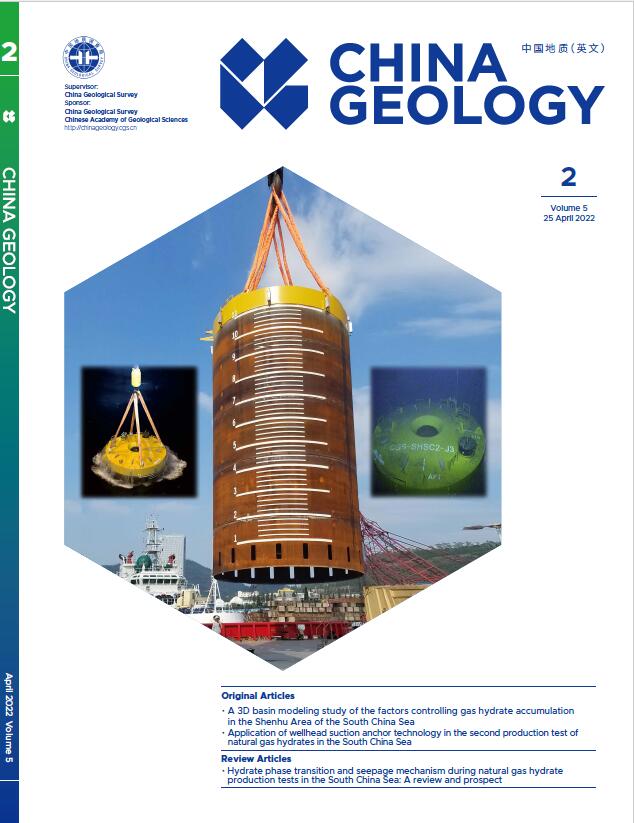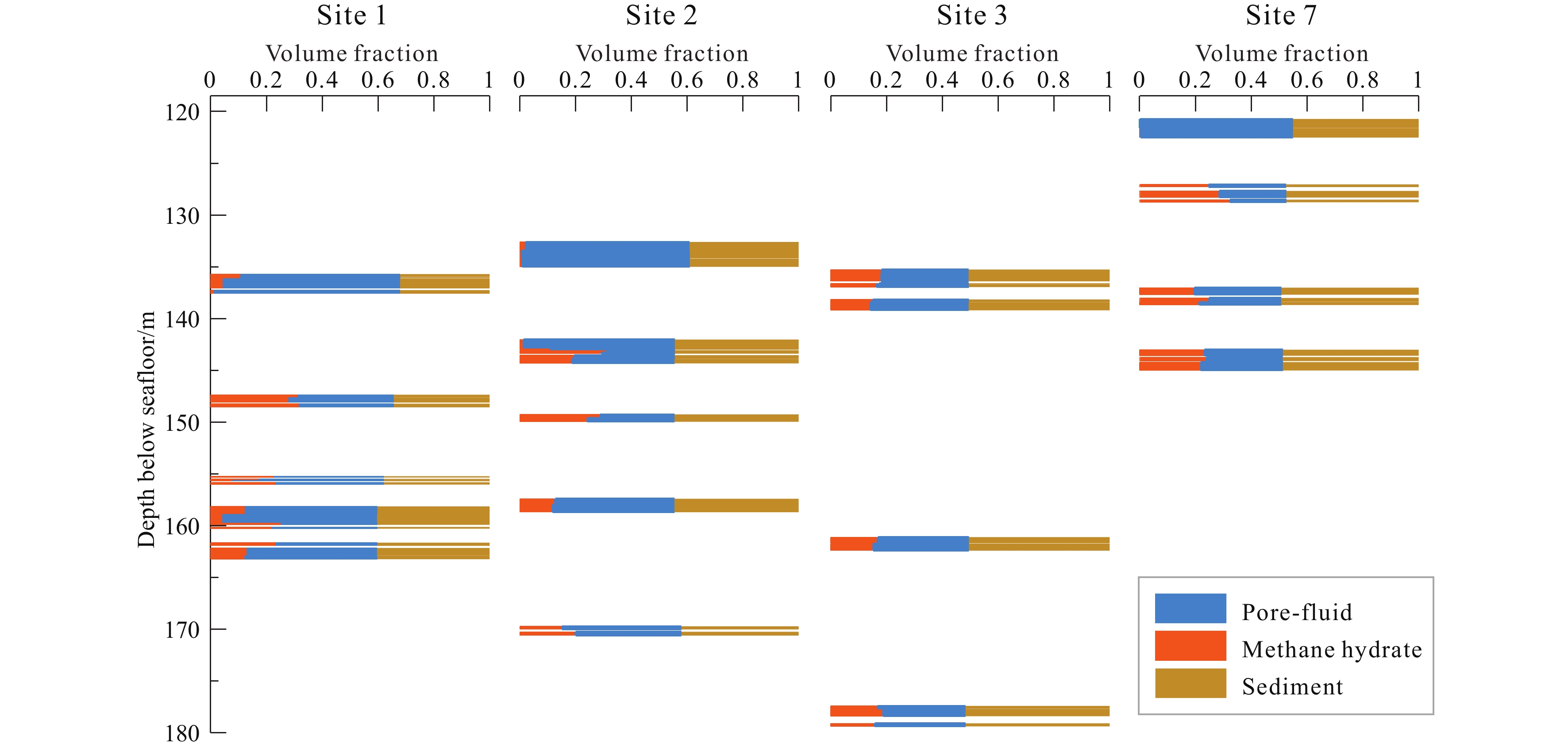| Citation: | Lin Lin, Jun Cao, Jin Qian, Jiu-jing Shang, Wei Zhang, Jin-gan Lu, Jin-qiang Liang, 2022. Velocity-porosity relationships in hydrate-bearing sediments measured from pressure cores, Shenhu Area, South China Sea, China Geology, 5, 267-275. doi: 10.31035/cg2022006 |
Velocity-porosity relationships in hydrate-bearing sediments measured from pressure cores, Shenhu Area, South China Sea
-
Abstract
Evaluating velocity-porosity relationships of hydrate-bearing marine sediments is essential for characterizing natural gas hydrates below seafloor as either a potential energy resource or geohazards risks. Four sites had cored using pressure and non-pressure methods during the gas hydrates drilling project (GMGS4) expedition at Shenhu Area, north slope of the South China Sea. Sediments were cored above, below, and through the gas-hydrate-bearing zone guided with logging-while-drilling analysis results. Gamma density and P-wave velocity were measured in each pressure core before subsampling. Methane hydrates volumes in total 62 samples were calculated from the moles of excess methane collected during depressurization experiments. The concentration of methane hydrates ranged from 0.3% to 32.3%. The concentrations of pore fluid (25.44% to 68.82%) and sediments (23.63% to 54.28%) were calculated from the gamma density. The regression models of P-wave velocity were derived and compared with a global empirical equation derived from shallow, unconsolidated sediments data. The results were close to the global trend when the fluid concentration is larger than the critical porosity. It is concluded that the dominant factor of P-wave velocity in hydrate-bearing marine sediments is the presence of the hydrate. Methane hydrates can reduce the fluid concentration by discharging the pore fluid and occupying the original pore space of sediments after its formation.
-

-
References
Abegg F, Hohnberg HJ, Pape T, Bohrmann G, Freitag J. 2008. Development and application of pressure-core-sampling systems for the investigation of gas- and gas-hydrate-bearing sediments. Deep Sea Research Part I: Oceanographic Research, 55, 1590–1599. doi: 10.1016/j.dsr.2008.06.006. Abid K, Spagnoli G, Teodoriu C, Falcone G. 2015. Review of pressure coring systems for offshore gas hydrates research. Underwater Technology the International Journal of the Society for Underwater, 33, 19–30. doi: 10.3723/ut.33.019. Chong ZR, Yang SHB, Babu P, Linga P, Li XS. 2016. Review of natural gas hydrates as an energy resource: Prospects and challenges. Applied Energy, 162, 1633–1652. doi: 10.1016/j.apenergy.2014.12.061. Collett TS, Johnson AH, Knapp CC, Boswell R. 2009. Natural Gas Hydrates: A Review. In: Collett TS, Johnson AH, Knapp CC, Boswell R (eds. ), Natural Gas Hydrates—Energy Resource Potential and Associated Geologic Hazards. American Association of Petroleum Geologists, 146‒219. doi: 10.1306/13201142m891602. Erickson SN, Jarrard RD. 1998. Velocity-porosity relationships for water-saturated siliciclastic sediments. Journal of Geophysical Research: Solid Earth, 103(B12), 30385–30406. doi: 10.1029/98jb02128. Helgerud MB, Dvorkin J, Nur A, Sakai A, Collett TS. 1999. Elastic-wave velocity in marine sediments with gas hydrates: Effective medium modeling. Geophysical Research Letters, 26(13), 2021–2024. doi: 10.1029/1999GL900421. Lee MW, Waite WF. 2008. Estimating pore-space gas hydrate saturations from well log acoustic data. Geochemistry, Geophysics, Geosystems, 9(7), Q07008. doi: 10.1029/2008GC002081. Li J, Lu Ja, Kang D, Ning F, Lu H, Kuang Z, Wang D, Liu C, Hu G, Wang J, Liang J. 2019. Lithological characteristics and hydrocarbon gas sources of gas hydrate-bearing sediments in the Shenhu area, South China Sea: Implications from the W01B and W02B sites. Marine Geology, 408, 36–47. doi: 10.1016/j.margeo.2018.10.013. Li JF, Ye JL, Qin XW, Qiu HJ, Wu NY, Lu HL, Xie WW, Lu JA, Peng F, Xu ZQ, Lu C, Kuang ZG, Wei JG, Liang QY, Lu HF, Kou BF. 2018. The first offshore natural gas hydrate production test in South China Sea. China Geology, 1(1), 5–16. doi: 10.31035/cg2018003. Liu LL, Liu CL, Wu NY, Ruan HL, Zhang YC, Hao XL, Bu QT. 2021. Advances in pressure core transfer and testing technology of offshore hydrate-bearing sediments. Geological Bulletin of China, 40(2‒3), 408‒422 (in Chinese with English abstract). Malinverno A, Kastner M, Torres ME, Wortmann UG. 2008. Gas hydrate occurrence from pore water chlorinity and downhole logs in a transect across the northern Cascadia margin (Integrated Ocean Drilling Program Expedition 311). Journal of Geophysical Research: Solid Earth, 113(B8). doi: 10.1029/2008JB005702. Mavko G, Mukerji T, Dvorkin J. 2009. The Rock Physics Handbook (2nd ed. ). New York, Cambridge University Press, 347‒350. doi: 10.1017/CBO9780511626753. Sava D, Hardage BA. 2009. Rock-physics models for gas-hydrate systems associated with unconsolidated marine sediments. In: Collett TS, Johnson A, Knapp C, Boswell R (eds.), Natural gas hydrates—Energy resource potential and associated geologic hazards. American Association of Petroleum Geologists, 505‒524. doi: 10.1306/13201121M893358. Schultheiss P, Holland M, Roberts J, Bigalke1 N, Mimitz M. 2017. Advances in wireline pressure coring, core handling, and core analysis related to gas hydrate drilling investigations. 9th International Conference on Gas Hydrate, Denver, Colorado USA. Schultheiss P, Holland M, Roberts J, Huggett Q, Druce M, Fox P. 2011. PCATS: Pressure core analysis and transfer system. 7th International Conference on Gas Hydrates, Amsterdam, Netherlands. Sloan ED, Koh C. 2007. Clathrate Hydrates of Natural Gases. Boca Raton, CRC Press, 1‒5. Su M, Sha ZB, Qiao SH, Yang R. 2015. Sedimentary evolution since Quaternary in the Shenhu hydrate drilling area, northern South China Sea. Chinese Journal of Geophysics, 58(8), 2975–2985 (in Chinese with English abstract). doi: 10.6038/cjg20150829. Su PB, Liang JQ, Zhang Wi, Liu F, Li TW, Wang FF, Wang XX. 2021. Numerical simulation of gas hydrate migration-accumulation system and trial mining optimization of orebodies in the Shenhu area. Geological Bulletin of China, 40(2‒3), 267‒279 (in Chinese with English abstract). Tishchenko P, Hensen C, Wallmann K, Wong CS. 2005. Calculation of the stability and solubility of methane hydrate in seawater. Chemical Geology, 219(1), 37–52. doi: 10.1016/j.chemgeo.2005.02.008. Tréhu AM, Ruppel C, Holland M, Dickens GR, Torres ME, Collett TS, Goldberg DS, Riedel M, Schultheiss P. 2006. Gas Hydrates in Marine Sediments: Lessons from Scientific Ocean Drilling. Oceanography, 19(4), 124–142. doi: 10.5670/oceanog.2006.11. Wei JG, Fang YX, Lu HL, Lu HF, Lu JA, Liang JQ, Yang SX. 2018. Distribution and characteristics of natural gas hydrates in the Shenhu Sea Area, South China Sea. Marine and Petroleum Geology, 98, 622–628. doi: 10.1016/j.marpetgeo.2018.07.028. Yun TS, Lee C, Lee JS, Bahk JJ, Santamarina JC. 2011. A pressure core based characterization of hydrate-bearing sediments in the Ulleung Basin, Sea of Japan (East Sea). Journal of Geophysical Research: Solid Earth, 116(B2). doi: 10.1029/2010jb007468. Zhang HT, Zhang HQ, Zhu YH. 2007. Gas Hydrate Investigation and research in China: Present Status and Progress. Geology in China, 34(6), 953–961 (in Chinese with English abstract). doi: 10.3969/j.issn.1000-3657.2007.06.001. Zhang W, Liang J, Wei J, Su P, Lin L, Huang W. 2019. Origin of natural gases and associated gas hydrates in the Shenhu area, northern South China Sea: Results from the China gas hydrate drilling expeditions. Journal of Asian Earth Sciences, 183, 103953. doi: 10.1016/j.jseaes.2019.103953. Zhang XD, Yin C, Zeng FX, Zhao B. 2021. Collective fluid flow system and its implications for gas hydrate accumulation in the north slope of the South China Sea. Geological Bulletin of China, 40(2‒3), 280‒286 (in Chinese with English abstract). Zhong GF, Zhang D, Zhao LX. 2020. Current states of well-logging evaluation of deep-sea gas hydrate-bearing sediments by the international scientific ocean drilling (DSDP/ODP/IODP) programs. Natural Gas Industry B, 8(2), 128–145. -
Access History

-
Figure 1.
Location of pressure-core recovered sites at Shenhu Area during GMGS4.
-
Figure 2.
Gamma density and P-wave velocity measured by PCATS for core 05A at Site 1, and LWD results from the same interval.
-
Figure 3.
Methane phase diagrams of all four sites used to identify the possible status of pressure-core samples.
-
Figure 4.
The concentration of methane hydrates, pore water, and sediments measured and calculated from pressure-core samples.
-
Figure 5.
Cross plot of P-wave velocity and concentration of sediments (a), methane hydrates (b), and pore-fluid (c). Color represents the methane hydrates saturation of pore space.
-
Figure 6.
Comparison between the predicted saturation of the methane hydrates and the measured data.





 DownLoad:
DownLoad:




